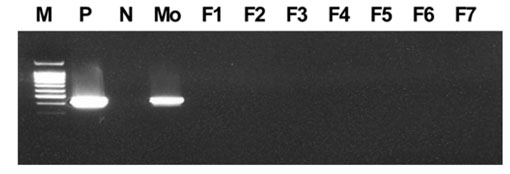J Vet Sci.
2006 Sep;7(3):225-228. 10.4142/jvs.2006.7.3.225.
Absence of vertical transmission of Helicobacter pylori in an experimental murine model
- Affiliations
-
- 1Department of Laboratory Animal Science, College of Medicine, Seoul National University, Seoul 110-799, Korea.
- 2New Drug Research Team, Research and Development Center, Daewoong Pharmaceutical Co., LTD., Yongin 449-814, Korea.
- 3Animal Disease Research Unit, College of Life Science and Natural Resources, Wonkwang University, Iksan 570-749, Korea. kimoj@wonkwang.ac.kr
- KMID: 1089905
- DOI: http://doi.org/10.4142/jvs.2006.7.3.225
Abstract
- Helicobacter pylori (H. pylori) infection is acquired mainly in early childhood but the precise transmission routes are unclear. This study examined the maternal H. pylori infection status in order to determine the potential of perinatal transmission. These issues were investigated using an experimental murine model, the Mongolian gerbil, which has been reported to be the most suitable laboratory animal model for studying H. pylori. Pregnant Mongolian gerbils, infected experimentally with H. pylori, were divided into two groups. The stomachs of the mother and litters were isolated and assessed for the transmission of H. pylori at the prenatal period (2 weeks after pregnancy) and at the parturition day. The bacterial culture, polymerase chain reaction (PCR) and rapid urease test were used to examine the presence of the transmitted H. pylori. There was no H. pylori observed in any of the fetuses during pregnancy and in the litters at parturition. This suggests that vertical infection during the prenatal period or delivery procedure is unlikely to be route of mother-tochild transmission of a H. pylori infection.
MeSH Terms
-
Animals
Animals, Newborn
Disease Models, Animal
*Disease Transmission, Vertical
Female
Gerbillinae
Helicobacter Infections/microbiology/*transmission
Helicobacter pylori/*growth&development
Male
Polymerase Chain Reaction
Pregnancy
Pregnancy Complications, Infectious/*microbiology
Specific Pathogen-Free Organisms
Stomach Diseases/*microbiology
Figure
Cited by 1 articles
-
Survey of Helicobacter infection in domestic and feral cats in Korea
Heh-Myung Ghil, Jong-Hyeon Yoo, Woo-Sung Jung, Tae-Ho Chung, Hwa-Young Youn, Cheol-Yong Hwang
J Vet Sci. 2009;10(1):67-72. doi: 10.4142/jvs.2009.10.1.67.
Reference
-
1. Fiedorek SC, Malaty HM, Evans DG, Pumphery CL, Casteel HB, Evans DJ Jr, Graham DY. Factors influencing the epidemiology of Helicobacter pylori infection in children. Pediatrics. 1991. 88:578–582.
Article2. Graham DY, Adam E, Reddy GT, Agarwel JP, Agarwel R, Evans DJ Jr, Malaty HM, Evans DG. Seroepidemiology of Helicobacter pylori infection in India. Comparison of developing and developed countries. Dig Dis Sci. 1991. 36:1084–1088.3. Hirayama F, Takagi S, Yokiyama Y, Iwao E, Ikeda Y. Establishment of gastric Helicobacter pylori infection in Mongolian gerbils. J Gastroenterol. 1996. 31:24–28.4. Honda S, Fujioka T, Tokieda M, Satoh R, Nishizono A, Nasu M. Development of Helicobacter pylori-induced gastric carcinoma in mongolian gerbils. Cancer Res. 1998. 58:4255–4259.5. International Agency for Research on Cancer. Schistosomes, liver flukes and Helicobacter pylori. IARC Monogr Eval Carcinog Risks Hum. 1994. 61:1–241.6. Jones NL, Sherman PM. Helicobacter pylori infection in children. Curr Opin Pediatr. 1998. 10:19–23.7. Kim SH, Kim OJ. Application of consensus polymerase chain reaction for monitoring of Helicobacter species. Korean J Lab Anim Sci. 2004. 20:316–320.8. Marshall BJ, Warren JR. Unidentified curved bacilli in the stomach of patients with gastritis and peptic ulceration. Lancet. 1984. 1:1311–1315.
Article9. Mendall MA, Goggin PM, Molineaux N, Levy J, Toosy T, Strachon D, Northfield TC. Childhood living conditions and Helicobacter pylori seropositivity in adult life. Lancet. 1992. 339:896–897.
Article10. Minoura T, Kato S, Otsu S, Fujioka T, Iinuma K, Nishizono A. Childhood Helicobacter pylori infection in a murine model: maternal transmission and eradication by systemic immunization using bacterial antigen-aluminium hydroxide. Clin Exp Immunol. 2003. 134:32–37.
Article11. NIH Consensus Conference. Helicobacter pylori in peptic ulcer disease. JAMA. 1994. 272:65–69.12. Rothenbacher D, Bode G, Berg G, Knayer U, Gonser T, Adler G, Brenner H. Helicobacter pylori among preschool children and their parents: evidence of parent-child transmission. J Infect Dis. 1999. 179:398–402.
Article13. Rothenbacher D, Inceoglu J, Bode G, Brenner H. Acquisition of Helicobacter pylori infection in a high-risk population occurs within the first 2 years of life. J Pediatr. 2000. 136:744–748.
Article14. Rothenbacher D, Winkler M, Gonser T, Adler G, Brenner H. Role of infected parents in transmission of Helicobacter pylori to their children. Pediatr Infect Dis J. 2002. 21:674–679.
Article15. Torres J, Perez-Perez G, Goodman KJ, Atherton JC, Gold BD, Harris PR, la Garza AM, Guarner J, Munoz O. A comprehensive review of the natural history of Helicobacter pylori infection in children. Arch Med Res. 2000. 31:431–469.
Article16. Watanabe T, Tada M, Nagai H, Sasaki S, Nakao M. Helicobacter pylori infection induces gastric cancer in Mongolian gerbils. Gastroenterology. 1998. 115:642–648.
Article
- Full Text Links
- Actions
-
Cited
- CITED
-
- Close
- Share
- Similar articles
-
- Time Trends in the Prevalence of Helicobacter pylori Infection and Future Directions in Korea
- Response to Treatment of Helicobacter pylori-associated Dyspepsia: Eradication of Helicobacter pylori or Correction of Gastric or Intestinal Dysbiosis?
- Treatment of Helicobacter pylori infection in functional dyspepsia
- Animal Models of Helicobacter pyori Infections
- Helicobacter pylori Infection and Cardiovascular Disease


